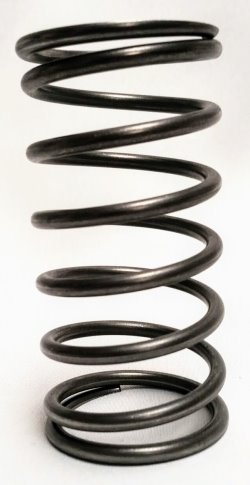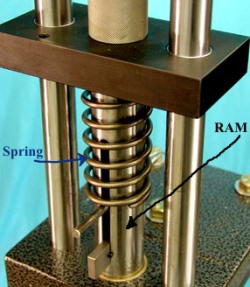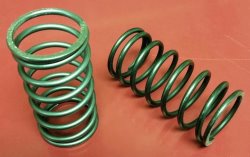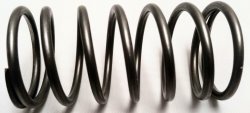|
|
|
CSP-2 and CHP-1 Retraction Spring
|
| |

|
Quantity in Basket:
None
Catalog No.: CSP-2SPR
Price: $19.50
Shipping Weight: 1.00 pounds
Sorry, we are no longer taking orders for the CSP-2 and CHP-1 Retraction Spring on our legacy website. Please visit our new website at Corbins.com for all future orders. Any question/concerns you can reach us at sales@corbins.com Thank you
|
| |

This is the large spring which surrounds the ram of the CSP-2 Mega Mite press. It is also used on the CHP-1 Hydro-Press. Unless we develop some new idea that would benefit from using a different spring, at some future date, the two have been and still are interchangeable.
The purpose of the retraction spring is to push down on the retraction pin, which in turn passes through the slot in the press ram and through hole in the internal punch head. This pushes down on the punch, so that it doesn't just remain "up" in the die and make it hard to put a new component into the die mouth.
Sometimes people will put this pin under the head of the punch, and bend or break it or the knock-out bar below it. Or will attempt to use it as a knock-out bar (which it will not do). So long as the pin goes through the 1/4-inch (nominal size) hole through the internal punch head, it is in the right place and will work as intended. The spring sits atop this pin. You have to raise the ram slightly to take tension off the spring, and then manually lift the spring up so that you can push the 4-inch long, 1/4-inch diameter retraction pin under the last coil and into the ram, through the hole in the punch (which may need to be rotated to align with the ram slot), and then center the pin so half of it sticks out on either side of the ram.
The knock-out bars go UNDER the pin and also under the head of the punch, by logical inference. The knock-out bar comes to rest on the top of the mounting plate or base plate when the ram goes down far enough. This stops the bar from moving any further down. The ram carries the die and punch further down, until the head (lower end) of the punch comes to rest on top of the knock-out bar. That stops the punch, while the ram and die continue on down, which pushes the bullet out of the die.
 With the hand press, you can tell if you have used the wrong height of knock-out bar, because you cannot lower the ram all the way with too tall of a bar in place, and you won't push the bullet all the way out of the die with too short of a bar. The right bar height raises the punch far enough to allow easy removal of the bullet, but still lets the ram go all the way down without resistance.
With the hand press, you can tell if you have used the wrong height of knock-out bar, because you cannot lower the ram all the way with too tall of a bar in place, and you won't push the bullet all the way out of the die with too short of a bar. The right bar height raises the punch far enough to allow easy removal of the bullet, but still lets the ram go all the way down without resistance.
On the Hydro-Press, the bottom sensor has to be set so it stops the downward movement of the ram and still leaves just a small amount of space between the lower (threaded) end of the die and the top of the punch head. If you can still turn the die by hand with the ram down and stopped, and the bullet is being pushed out of the die far enough to grasp it, you have the bottom sensor in the right position.
At the bottom of the stroke, the spring should still have visible space between the coils even if it is "fully compressed". Fully compressed does NOT mean "coil-bound" where the entire spring is mashed together with no space between the coils. If you find that the knock out bars are mashing the spring this way at the bottom of the stroke, then you are using the wrong knock out bar for the length of the punch head, or your bottom sensor is set too low on the Hydro Press. Ejection should take place before the spring is completely compressed into a solid stack of steel. Mashing the coils against each other causes the spring to fail eventually. Normal opertional life of the spring is measured in decades (most of the presses in operation for over 40 years still have the original spring).
But there is a risk of breaking the knock-out bar if you set the bottom sensor so that the full force of the Hydro Press pushes the die against the top end of the punch head, which in turn shoves down on the top of the knock-out bar. The bar is hardened steel and will handle any normal force needed to push the punch up through the die. The Hydro-Press can generate a tremendous force, though. It must stop moving down BEFORE all the space is used up between the punch head, die, and knock-out bar, and it will if the bottom sensor is set correctly. Even a couple of thousandths of an inch is enough so the only force on the knock-out bar will be the ejection force for the component, not the output of the press straining to go down past the top of the bar.
If you find that you are breaking knock-out bars, stop what you are doing, and examine the position of the bottom sensor. See if you can turn the die and punch by hand at the bottom of the stroke. If you cannot do it, then the end of the internal punch is probably jammed up against the top of the k.o. bar with no slack at all at the top, between punch head and die.
Don't assume that there must be some design flaw and a tougher knock-out bar is required! That would be like a fellow driving his car into brick walls and assuming that the car just isn't built right since it keeps crumpling up! For normal operation, the k.o. bar that comes with your press is the one everyone else has been using for decades, with no problem. It seems unlikely that the design suddenly become too weak just to play a trick on you! Probably the issue is something else... bottom sensor too low, press force against the bar instead of just ejection force, all of which are easily handled by a slightly higher move of the sensor.

|
|










With the hand press, you can tell if you have used the wrong height of knock-out bar, because you cannot lower the ram all the way with too tall of a bar in place, and you won't push the bullet all the way out of the die with too short of a bar. The right bar height raises the punch far enough to allow easy removal of the bullet, but still lets the ram go all the way down without resistance.
























